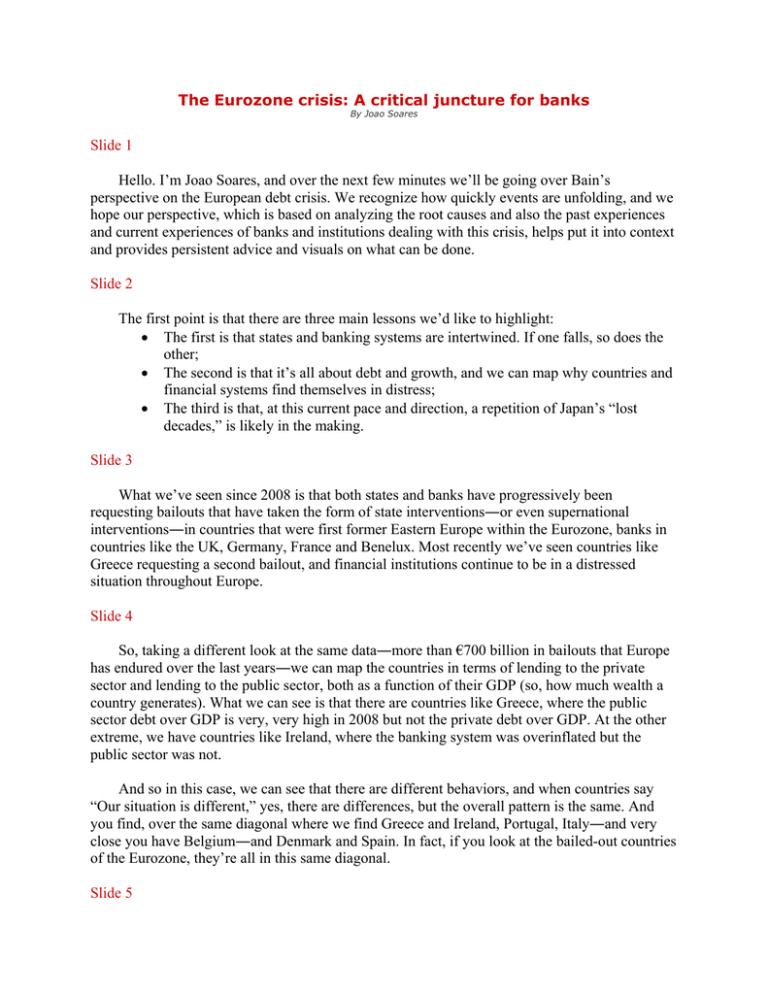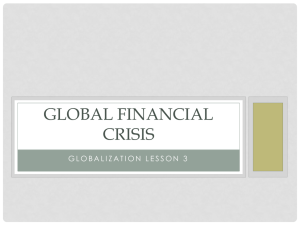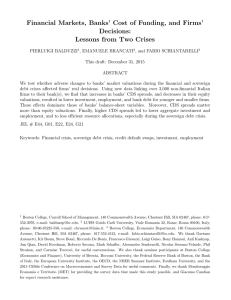The Eurozone crisis: A critical juncture for banks
advertisement

The Eurozone crisis: A critical juncture for banks By Joao Soares Slide 1 Hello. I’m Joao Soares, and over the next few minutes we’ll be going over Bain’s perspective on the European debt crisis. We recognize how quickly events are unfolding, and we hope our perspective, which is based on analyzing the root causes and also the past experiences and current experiences of banks and institutions dealing with this crisis, helps put it into context and provides persistent advice and visuals on what can be done. Slide 2 The first point is that there are three main lessons we’d like to highlight: The first is that states and banking systems are intertwined. If one falls, so does the other; The second is that it’s all about debt and growth, and we can map why countries and financial systems find themselves in distress; The third is that, at this current pace and direction, a repetition of Japan’s “lost decades,” is likely in the making. Slide 3 What we’ve seen since 2008 is that both states and banks have progressively been requesting bailouts that have taken the form of state interventions―or even supernational interventions―in countries that were first former Eastern Europe within the Eurozone, banks in countries like the UK, Germany, France and Benelux. Most recently we’ve seen countries like Greece requesting a second bailout, and financial institutions continue to be in a distressed situation throughout Europe. Slide 4 So, taking a different look at the same data―more than €700 billion in bailouts that Europe has endured over the last years―we can map the countries in terms of lending to the private sector and lending to the public sector, both as a function of their GDP (so, how much wealth a country generates). What we can see is that there are countries like Greece, where the public sector debt over GDP is very, very high in 2008 but not the private debt over GDP. At the other extreme, we have countries like Ireland, where the banking system was overinflated but the public sector was not. And so in this case, we can see that there are different behaviors, and when countries say “Our situation is different,” yes, there are differences, but the overall pattern is the same. And you find, over the same diagonal where we find Greece and Ireland, Portugal, Italy―and very close you have Belgium―and Denmark and Spain. In fact, if you look at the bailed-out countries of the Eurozone, they’re all in this same diagonal. Slide 5 The four lenses we use are mostly “balance sheet-centric:” The first lens is around the size of the loan book, whether a financial system is―or isn’t―overinflated, and the risk of including real estate bubbles, both on the residential and the commercial side; The second lens is also on the asset side, but it’s about the exposure that each of the financial institutions and the systems have to sovereign debt, most notably of the periphery countries; The third lens looks at the other side of the balance sheet, notably in terms of funding and capital―the ability to fund the assets with deposits or wholesale, and the implications for the stability and the levels of risk going forward. The fourth lens is the structure―the level of fragmentation in each of the financial services sectors in order to ascertain whether there is or isn’t an incentive for smaller entities to take additional risk (and, thus doing, creating a situation of additional stress for their banking system). Slide 6 The chart here is around house prices over GDP per capita. Europe has suffered a number of housing bubbles in the last decade. Slide 7 This chart is around the sovereign-debt dimension and mapping the interbank exposure to Greece, Ireland, Italy, Portugal and Spain, as well as the core tier-one ratio of the banks, with the effect of that sovereign exposure being taken into account. And there is a red quadrant of most vulnerable financial institutions to this dimension. Slide 8 The third chart takes us back to 2008. At the beginning of this crisis, the financial systems in these countries had very different profiles in terms of recourse to wholesale funding, or in reverse, how much was financed by deposits. Ireland was an extreme case, far in excess of 200 percent, but other countries that exceeded traditional levels included Portugal and Italy, and even Spain and France were in similar circumstances. Slide 9 This is particularly relevant as countries and banks are now fighting for a very scarce resource of funding. Over the next few years, especially in 2012, these entities will all be fighting for very scarce resources. Slide 10 What does this all entail? We see two paths: The first is a state path and the second is a bank path, but they will end up in the same curve. In the first path, as in the case of Greece, there is a debt buildup and sovereign downgrades; and it leads to too much debt compared with GDP. In the other one, as in the case of Ireland, the banks had liquidity events as the price declined, driven by bubbles; a capital shortfall led to too much debt; and that, in turn, drove the countries to introduce austerity. The spiral begins. So, austerity led to consumption declines. That led to the SMEs [small and medium-sized enterprises] having bankruptcies, to unemployment going up, to NPLs [non-performing loans] increasing both on the corporate side and on the residential side and being recognized in the balance sheets of the banks, creating sovereignty issues that required additional support, usually by the states, which forced the states to take more debt. Then they introduced more austerity―and the cycle continues. Slide 11 Where does this lead us? If you go back to the first matrix, it takes us to an evolution that has driven most countries farther to the right, such as Greece, Ireland, Portugal and the UK, and many countries remain where they were in terms of private- debt-to-GDP. So they haven’t yet deleveraged the financial system, the exception being Ireland, where that decline has started to occur. Slide 12 We have, in the end, four different paths: The first one is the case of Ireland, in which there was a previously healthy state and overextended banks. Neighbors in this group include Denmark, which is of a different profile because it’s not within the Eurozone, and Spain to a lesser extent; Group two is countries that have previously healthy banking systems but overextended states, such as Greece and Italy; Group three includes Portugal and the UK. Both the state and the banks were slightly overexposed, to the point where they’ve entered a need for austerity and are in some distress; Group four is healthy states but exposed to deterioration. Slide 13 We are currently at a juncture, and there are four main scenarios that we envision. We recognize the situation is evolving very, very rapidly, but we also believe that looking at the root causes―and also at the lessons of history and at how other players have been coping with the situation―provide a meaningful read for what the macroevolution is likely to be, as well as the lessons for each of the banks. We can either face an extreme of total meltdown; a broad bankingsystem crisis, and a contagion even beyond the Eurozone; or, on the other extreme, a stronger center in a more federation-like reality for Europe. The current course is the limp-along status quo, in which what we have are bailouts at each new crisis. Each new development, each new rapid development, forces governments, banks and regulators to take action. Austerity measures are introduced. We find impaired growth, originally in the periphery economies but spreading through the remainder of Europe and even the core exporters, like Germany, facing a dire situation. And this affects not only the overall states but the real economy and the financial institutions, which will have to cope differently, respective of where they are. Slide 14 There are shared top priorities for all entities. The first one is around liquidity. Second one is around long-term funding. The third one is about disposing of high-risk and specific asset categories. And the last one is cost efficiencies that need to be pursued in a totally different approach than we’ve seen in the last 20 years. The quadrants highlight very different paths to action. Carpe diem represents those institutions that have had a high resistance to sovereign-debt exposure in the balance sheets and are more robust in terms of the intrinsic quality of their assets and their funding. These entities can build scale in their home markets and take advantage of their competitors’ weaknesses to either acquire assets or redeploy their actions, market and saleswise, in those markets to take additional share. The Stop the rot group has a deteriorated (or deteriorating) balance sheet. It requires a refocusing around the future core―which entails segregating bad loans, not only the ones you currently have but also those that are likely to go into a more deteriorated position in the next 18 months―creating investment headroom and repositioning for growth so that, when you are repositioned to a future core, you have the muscle to take advantage and gain share. The third quadrant, Brace for survival, is a question of resilient balance sheet, except for exposure to sovereign debt. This entails disposing of high-risk portfolios, raising capital and very aggressively managing costs down―again, in a very different way than has been done in the past. Lastly, the group of Highest concern entails taking the same actions in terms of bad loans and segregating them, identifying a stronger core or a resilient core. The crises over the last 20 years show us that the banks that successfully come out of this quadrant are the ones that refocus around a much smaller core and reenergize their assets, their people and their talent around a much narrower focus. These are the key messages that we’ve seen working with banks and institutions throughout Europe, and that we believe can be helpful for you. Slide 15 Thank you for your time, and if you have any questions, please don’t hesitate to reach out to either me or my Bain partner colleagues.



